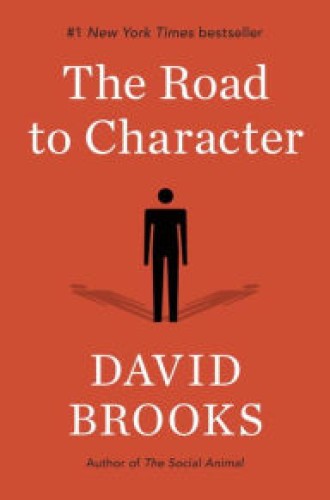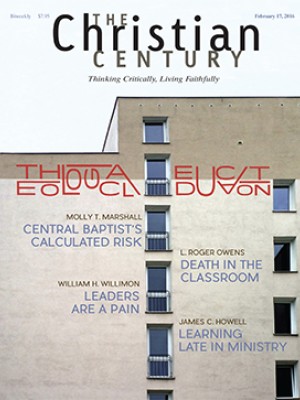Cultivating character
In this learned, beautifully written, and often hilarious book, New York Times columnist David Brooks reflects on virtues that form desirable character traits in individuals as well as in the wider culture. He ranges over a rolling landscape of human experience, sharpening his vision through the lens of classic literary, theological, and philosophical texts, as well as insights drawn from his work as a journalist. He offers biographical case studies to show how things have worked out in the complexities of daily life. Along the way, he treats readers to minisermons on topics such as the delicate textures of long-married love (“Love you? I am you”). Brooks says that as he wrote the book, he was unsure whether he could follow the road to character himself, but he wanted to figure out what it “looks like and how other people have trodden it.”
The volume rests on a fundamental distinction between two sets of traits that Brooks calls résumé virtues and eulogy virtues. Drawing on Rabbi Joseph Soloveitchik’s 1965 masterwork The Lonely Man of Faith, he explains that the former virtues express themselves in a bundle of features he dubs Adam I, the latter in a bundle called Adam II.
Read our latest issue or browse back issues.
Résumé—or Adam I—virtues are the ones we feature in the job market when we tout our skills and showcase our ability to build, produce, create, and discover. They help us claim success by beating out the competition. Résumé virtues are valuable as far as they go. But unrestrained, they perpetuate many of life’s most intractable problems: greed, racism, sexism, violence, perversity, deception, and—worse—self-deception.
In contrast, eulogy—or Adam II—virtues are the ones we hope others will talk about at our funeral. Brooks’s accounting of them is considerably longer, partly because he is more interested in them and partly because they are subtler and require more nuanced descriptions. Definitions are elusive, but a good start would emphasize courtesy, kindness, courage, honesty, loyalty, and self-discipline. Eulogy virtues foster self-criticism, an inner moral gyroscope, a clear sense of identity, an awareness of fallibility, and a willingness to sacrifice for others. These virtues are developed, not discovered. They come slowly and are engraved on the heart, stroke by stroke. They also come indirectly. The action comes first, then the habit.
To be sure, eulogy virtues carry dangers when people take them to extremes. Benevolence, for example, can lead to condescension, principles to dogmatism, serenity to smugness, and reticence to aloofness.
Brooks does not really say what the heart of résumé virtues is, but he leaves no doubt that the heart of eulogy virtues is humility. This might be the most elusive virtue of all because we cannot seek it. Nor can humility be taught; rather, we see it modeled in certain people. Sensing that fulfillment is relational, humble people see themselves as part of a larger story, as a thread in a longer narrative. They know too, with Immanuel Kant, that humanity is “crooked timber.” So humble people try to confront their own moral limitations, squarely and without flinching. At the same time, they grasp that their moral limitations cannot be expunged, but can only be managed. The solution lies in palliatives, not cures.
Most important, humble people understand that the line between virtue and vice runs not between races or genders or nations, but deep within each person. The line is not firmly drawn but blurs as it moves from place to place and from time to time. Humans are dappled souls, seeking the light but never owning it. Reinhold Niebuhr got it right: “Beset by his own sinful nature, man is a problem to himself.”
So where is the road to character? Brooks emphasizes that it begins with constant small acts of self-discipline—gestures that keep Adam I in line and give Adam II a chance. And it develops from respect for tradition. Born of centuries of trial and error, tradition helps us see the difference between the transitory and the permanent and between passing happiness and enduring joy.
Of course, the past, the cradle of tradition, was not entirely good. It was more racist, more sexist, and more ethnocentric. Whether it was more violent is less clear. But at least this much is true: the past provided a moral vocabulary for appreciating the deeper textures of our lives. That vocabulary made it clear that sin is not a fattening dessert but a fundamental perversity “baked into our nature and . . . handed down through the generations.” Being good is not the same as doing good.
Adam II does not have much of a chance in the United States. Contemporary culture perpetuates the illusion that résumé virtues are everything. One Gallup poll showed that in 1950, 12 percent of high school seniors saw themselves as a very important person. In 2005, 80 percent did. No wonder. Commencement speakers routinely tell students to focus on themselves, to ask themselves what it takes to make themselves happy and self-fulfilled. Follow your stars, they say. Your stars.
This is where calling comes into the story. A calling is not a career. A career can be swapped out whenever a better chance for praise or money or status comes along. A calling, on the other hand, comes from the outside—from an encounter with a biblical passage, a piece of music, a work of art, a natural disaster, the face of a child. In a very real sense a calling is nonnegotiable. We do what we are called to do because we have to. It is a long obedience.
The point is not that some lines of work are noble callings while others are just careers. Rather, the difference resides in how we do our work. Heartily? With a commitment to excellence? As they say, God loves adverbs. By now we are well on the road to character.
However, the bulk of the book falls not in these ruminations but in case studies of people who exemplified the bracing tension between Adam I and Adam II. The subjects of these case studies are diverse: male and female, white and black, religious and secular, single and married, ancient and modern. What they have in common is that they were all flawed, and yet—this is crucial—they all struggled to confront their demons. All of them measured success not by winning, and certainly not by attracting others’ approval, but by staying the course. The goal was not to be better than other people, but to be better than they used to be.
Brooks’s biographical subjects are not the usual suspects—Billy Graham, Mother Teresa, or Martin Luther King Jr.—but people whom history has applauded more for their Adam I traits. He takes pains to show that history’s rendering of them is incomplete. Brooks’s main actors are Frances Perkins, FDR’s secretary of labor; Dwight D. Eisenhower; Dorothy Day, cofounder of the Catholic Worker movement; General George C. Marshall, a Nobel Peace Prize winner; A. Philip Randolph, founder of the Brotherhood of Sleeping Car Porters; Bayard Rustin, a civil rights activist; Mary Ann Evans (George Eliot), author of Middlemarch; Augustine of Hippo; Samuel Johnson, essayist and lexicographer; and Johnny Unitas and Joe Namath, legendary quarterbacks. In most chapters Brooks weaves in the stories of influential supporting actors—mentors, mothers, lovers, colaborers. Chapter titles are revealing: “The Summoned Self,” “Self-Conquest,” “Struggle,” “Self-Mastery,” “Dignity,” “Love,” “Ordered Love,” “Self-Examination.”
The case studies brim with memorable lines. We find penetrating insights: “I hope that in victory we are more grateful than proud,” wrote war correspondent Ernie Pyle just before the end of World War II. And striking quotations: “Large angels,” one contemporary said of Mary Ann Evans, “take a long time unfolding their wings, but when they do, soar out of sight.” And bone-dry wit: Eisenhower “looked simple and straightforward, but his simplicity was a work of art.” To achieve his purposes Ike “was willing to appear more stupid than he really was. (This is how we know he was not a New Yorker.)”
Late 19th-century Protestant liberals, the historian Elesha Coffman has noted, wrote about conversion experiences taking place not on the sawdust trail but in the library, in the pages of a life-changing book. More than once Brooks forced me back to the drawing board of my own life, to wonder how often the usually futile pursuit of Adam I virtues had steered me off the road to character. Slowly I realized that this is a high-stakes text. It made me do more than think. It made me reassess.






